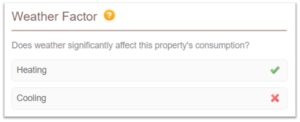A building’s energy use and expense can be impacted by many factors, including seasonal swings in weather. The impacts of weather can even mask or falsely inflate the benefits of energy efficiency projects. This Tutorial Video shows you how to leverage the Weather Profile in EnergyPrint’s Utility Dashboard. Learn how weather normalization works, and quickly see if weather is impacting your building’s energy performance. (Note: This tutorial is also available in the Videos tab of the Utility Dashboard)
What Is the Weather Profile?
By correlating specific energy use to local weather data, the Weather Profile provides the next level of energy performance diagnostics. It helps identify if and when a change may have occurred and where to focus your next level of investigation, allowing you to prove projects are performing as expected, or identify opportunities for improvement.
How Do I Use It?
- Determine if weather is impacting your heating and cooling performance
-A green check indicates there is a strong relationship between weather and energy consumption
-A red x indicates something other than weather is significantly impacting energy consumption - Review “Weather Normalized Data” for year-over-year changes in performance by heating, cooling and baseload categories
- Look for consistent trending on the Weather Normalized Property Trends graph
-If trending horizontal, then the property is consistently consuming energy as predicted with changes in weather
-If trending up or down, look back to the point of change and inquire what operational or mechanical changes may have taken place, or provide a recommendation to investigate - Tag findings as a “Note” on the Property Trends graph
What Are the Benefits?
Weather Normalization gives you a complete energy consumption picture without having to digest mounds of energy data or invest in manual analysis. The Utility Dashboard visualizes and communicates:
- The role weather plays in building performance
- Where seasonal improvement opportunities exist
- The cost avoidance of managing energy more effectively
- How each building compares to peers (actual and normalized results) from season to season and between geographic regions
- Whether efficiency savings are maintained over time
 |

